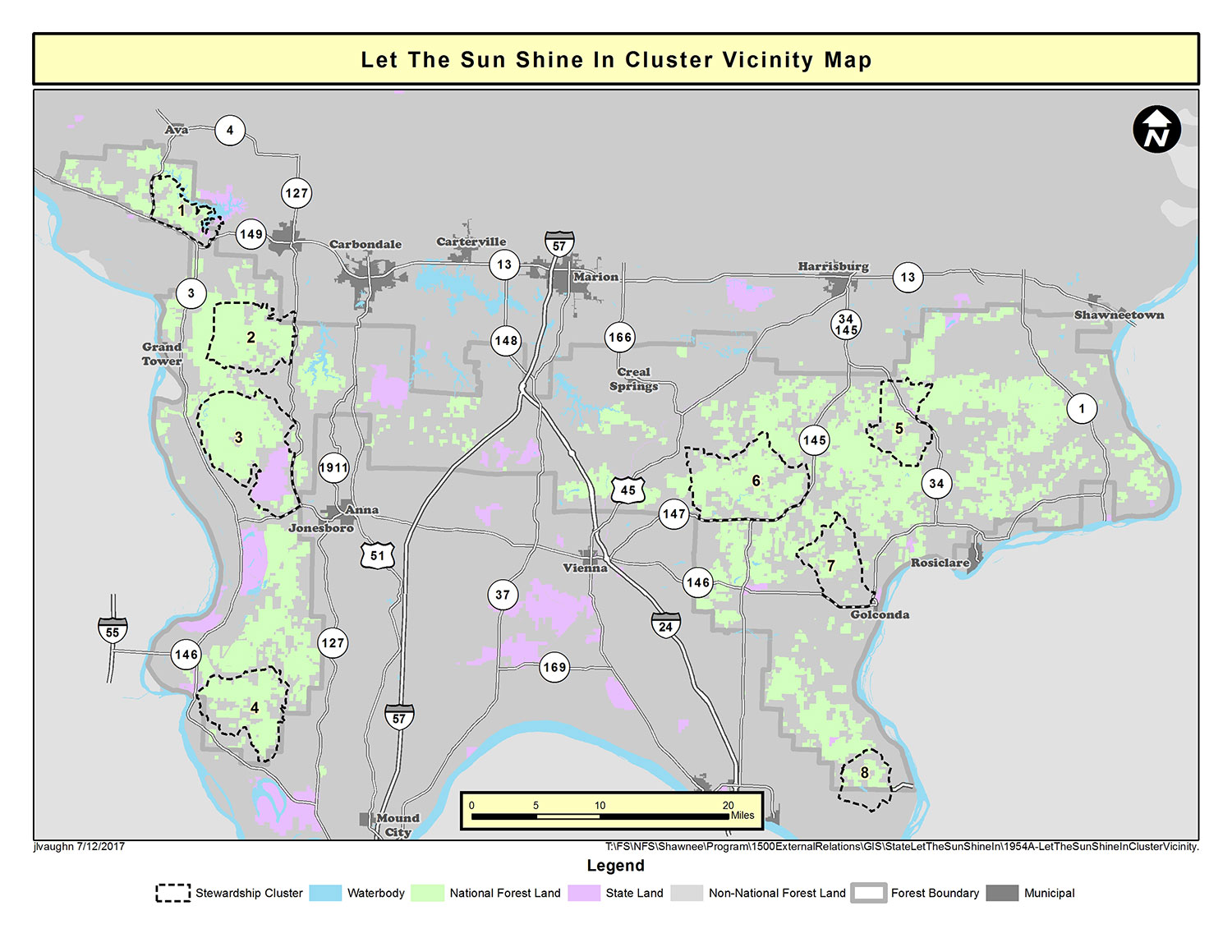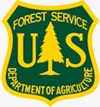What do we know about how to save oak-dominated forests?
Collaborations between biologists and foresters are leading to a shared vision of how to save oak forests. There is an agreement that the process can include carefully planned over-story tree removals, mid-canopy thinning of small trees, the use of prescribed fire, and treatment of invasive species. On a demonstration site in the Trail of Tears State Forest, the Illinois Department of Natural Resources (IDNR) is applying different combinations of management techniques and monitoring the results.

Why manage forests?
As citizens and outdoor enthusiasts, we are used to the idea of managing fish populations via creel limits. And we understand the need for and value of hunting and trapping seasons for managing wildlife populations. But many people don’t realize the importance of managing forests, and that’s a problem, especially in southern Illinois.
It’s easy to understand this disconnect because forests can appear to be rather unchanging. But the majority of our southern Illinois forests haven’t been healthy in many years and are in desperate need of management.
In the absence of natural disturbances, like fire, the historically oak-dominated forests of southern Illinois are converting to forests that will soon be dominated by shade-tolerant tree species like beech and maple.
Because oak trees need lots of sunshine reaching the forest floor to regenerate, too much shade is a nail in the coffin for oaks. And today, in much of southern Illinois, there are almost no young oaks in the forest. The forest that remains is essentially an old-folks home for old oaks.
And invasive species like bush honeysuckle and Japanese stilt grass, and many others, often compound the problem by blanketing the forest floor or cluttering up the mid-canopy adding to the shade problem and making oak regeneration all but impossible.
The good news is that there are forest management actions that can reverse oak decline, and efforts are underway to restore the public forested lands of southern Illinois.
However, 80% of the forested land in the state is privately owned, so saving Illinois oak forests is going to require private landowner participation.
District Foresters for the IDNR are the go-to folks with any questions about managing your forest. They can answer any questions you have about managing your forest and help guide you through the process of developing a forest stewardship plan for your property.
What forest management techniques are used?
There are a few common techniques that are used to manage the beautiful forests of Southern Illinois. Here are some of the techniques that we use at Let The Sun Shine In.
Prescribed Fire
Oaks are specially adapted to handle fire and, indeed, they need fire to persist on the landscape. But in the absence of fire for the last roughly 100 years, the forest canopy has closed in and there’s not enough light reaching the forest floor. This slow darkening of the forest has favored the growth of shade-tolerant tree species like beech and maple and prevented oaks from regenerating.
Additionally, a whole suite of non-native plant species, including bush honeysuckle and Japanese stilt-grass, have invaded the forests of southern Illinois over the last several decades blanketing the forest floor, often making the forest difficult to walk through, and further complicating oak regeneration.
This slow conversion from predominantly oak forests to predominantly beech-maple forests full of invasive species is almost invisible to most folks, but the birds and the squirrels and wildflowers and all the other plants and animals that depend on healthy oak forests are being significantly impacted.
And if you’re a landowner, your ability to harvest oak from your woodland is going to come to a screeching halt sooner than later, if you don’t start managing for oaks.
Prescribed or controlled burns, as they are also called, are an important tool in the forest management toolbox. You might have seen one of these on public land or maybe on a neighbor’s property.
Prescribed burns in oak forests are thoroughly planned out and professionally supervised fires set intentionally with the goal of helping to open up the forest again.
Burn seasons in southern Illinois are mostly in the fall and spring months, when much of the plant and animal life in the forest is either dormant, hibernating, or has migrated south.
A successful burn, or more often, a series of successful burns can help to open up the forest understory and address problems with invasive species. In doing so, prescribed burns can improve forest health, including improving conditions for oak regeneration.
If you have a Forest Stewardship plan that includes prescribed fire as a management action or if you are interested in learning more about using fire to manage your woods, you can reach out to an IDNR District Forester and he or she will be able to assist you. The Southern Illinois Prescribed Burn Association is another resource that can provide guidance and assistance to landowners.
Invasive Species Control
An invasive plant is one that is not native to an area but has been introduced and is causing damage to the natural environment. Since these plants are in a new environment, free from the natural predators, parasites, or competitors of their native habitats, they often run ‘amuck’ and can out-compete and displace native species, reducing wildlife food and habitat in the process, and potentially disrupt entire ecosystems.
In southern Illinois forests, there are literally dozens of invasive plant species that represent various types of threats to the forest ecosystem, and that number is growing. Woody species like bush honeysuckle grow as shrubs in the forest understory limiting the amount of light that can reach the forest floor. Herbaceous species like Japanese stilt grass and garlic mustard can blanket the forest floor and prevent seed germination in native plants.
Unfortunately, if you are a landowner in southern Illinois, then you likely have a suite of invasive species on your forested property (on all your property, really).
The good news is that if you have a Forest Stewardship Plan for your property, then it likely includes detailed recommendations specific to invasive species control.
For example, “Control invasive shrubs to prevent bush honeysuckle from taking over. Cut and treat the stumps with a 25% solution of glyphosate from September to February. Control autumn olive shrubs along the edge, to prevent the spread of seeds by birds. Follow-up invasive control will be necessary on this stand.”
Guidance on implementing these recommendations can be sought through your local IDNR District Forester. There are also educational resources available through the University of Illinois Extension – Forestry.
The River-to-River Cooperative Weed Management Area (CWMA) is another resource that can aid landowners with invasive species control. The CWMA is a partnership between 13 federal and state agencies, organizations, and universities aimed at coordinating efforts and programs for addressing the threat of invasive plants in Southern Illinois.
Forest Stand Improvement
In the absence of large-scale natural disturbance for the last roughly 100 years, the oak-dominated forests of southern Illinois are slowly converting to beech-maple forests, because as the forest canopy has closed over the last several decades, the shade-tolerant beeches and maples have thrived while the sun-loving oaks have failed to regenerate.
As such, Forest Stand Improvement (FSI) is a common management action recommended in Forest Management Plans.
FSI consists of practices that guide or influence a forest stand to meet a particular objective, such as improving habitat for various wildlife species, changing plant species composition, or influencing the structure and visibility within a stand to meet aesthetic objectives.
Common approaches to FSI include thinning young stands, crop or “mast” tree management or release, and girdling. “Mast” is the seed and fruit produced by trees and shrubs and is an important food for many species of wildlife. Thinning focuses on the removal of poor growing stock while retaining good trees evenly across the stand.
Additionally, a whole suite of non-native plant species, including bush honeysuckle and Japanese stilt-grass, have invaded the forests of southern Illinois over the last several decades blanketing the forest floor, often making the forest difficult to walk through, and further complicating oak regeneration.
These problems can begin to be addressed through FSI activities.
If you have a Forest Stewardship plan that includes forest stand improvement as a management action, then you can reach out to an IDNR District Forester for additional questions and he or she will be able to assist you.
Overstory Tree Removal
The historically oak-dominated forests of southern Illinois are converting to beech-maple forests due to a lack of natural disturbance for almost 100 years. During this time the once relatively open forest canopy has mostly closed in. This slow darkening of the forest has favored the growth of shade-tolerant tree species like beech and maple and prevented oaks from regenerating.
While the use of prescribed fire and treatment of invasive species can help clear the understory, these management actions do not sufficiently address the problem of not enough sunlight getting to the forest floor.
As such, overstory tree removal is often a management action that is recommended in a Forest Stewardship Plan.
Perhaps more commonly referred to as a timber harvest, the ecological goal of removing selected trees from the forest is to improve the overall condition of the forest, specific to the objectives of the management plan.
However, timber harvests are not as simple as just cutting harvestable trees. There is a science and a process associated with a professional timber harvest that will usually involve pre- and post-harvest activities, as well as careful tree selection to ensure that the wildlife value of the forest is maintained and that the forest is left in a condition that will allow it to regenerate.
Specific to oak forests, for example, research has shown that a canopy cover of between 20-60%, depending on the site, should be a goal for encouraging oak regeneration. Seed trees need to be left, as well.
If you have a Forest Stewardship Plan that includes timber harvest as a management action, then you can reach out to an IDNR District Forester for additional questions and he or she will be able to assist you by recommending reputable loggers, answering your questions about harvest operations, and providing oversight of your timber harvest.
Demonstration Area
Oak forests in southern Illinois are in trouble and that’s bad news for the hundreds of plant and animal species that depend on healthy oak ecosystems.
Although big oak trees are still common in southern Illinois forests, they are reaching the end of their lifespans and there are almost no younger oak trees to take their place.
This conversion from mostly sun-loving oaks and hickories to mostly shade-tolerant beech and maple trees is happening, in part, due to a lack of natural disturbance in our forests for almost 100 years.
The good news is that there is a suite of forest management practices that can help reverse this trend and a demonstration project at the Trail of Tears State Forest, in southern Illinois, is testing the use of different combinations of those management techniques and monitoring the results.
The nearly 1,000-acre project, coordinated by the Illinois Department of Natural Resources, is using different combinations to prescribed fire, understory thinning, and overstory tree harvest to determine the best way to help revitalize ailing oak forests in southern Illinois.
Biologists are also monitoring the plant and animal response to these efforts to ensure that the desired effect is being accomplished.
The demonstration project is being modeled after similar successful projects in Missouri and Indiana and our Illinois effort promises to provide valuable insight and guidance to IDNR District Foresters as they make forest management recommendations to private landowners.
The public is encouraged to visit the demonstration area at Trail of Tears and see ‘management in action’. There is an informational kiosk located along the North Forest Road and signage along trails in the area explains what a visitor is seeing.
Visiting the site can be a valuable experience for a private landowner planning to implement similar management practices on his or her property. And ‘control’ tracts adjacent to ‘experimental’ tracts clearly demonstrate the different look of a managed versus an unmanaged forest.
You will see that the managed tracts are more open and that there is more sunlight getting through the canopy and down to the forest floor. This sunlight is the key to getting new oak trees to grow and will also encourage the growth of woodland wildflowers.
And this is what your forest can and should look like.
A Vision for the Future
Oak-dominated forests cover hundreds of thousands of acres in; Missouri, Arkansas, Illinois, Ohio, Tennessee, and Kentucky, making-up an area known as the ‘central hardwoods’. These oak forests support many other species directly or indirectly – from deer and turkeys to migrating songbirds, to wildflowers and pollinators. As such, a loss of oaks would be bad news for the species that depend on them.
The Let the Sun Shine In program is making great conservation strides in Illinois and is poised to do big things. As these successes continue to mount, we look forward to exporting this cutting-edge approach to neighboring states with oak forests and similar problems. And that could add up to letting a lot of sun shine into oak forests and making a BIG Difference!!
NEWS& RESOURCES
Read articles and watch videos that tell the story of efforts to protect and restore oak forest ecosystems in Southern Illinois.
Help us to preserve the forests of Southern Illinois!
LET THE SUN SHINE IN
BECAUSE WITH SUN SHINE COMES LIFE.








